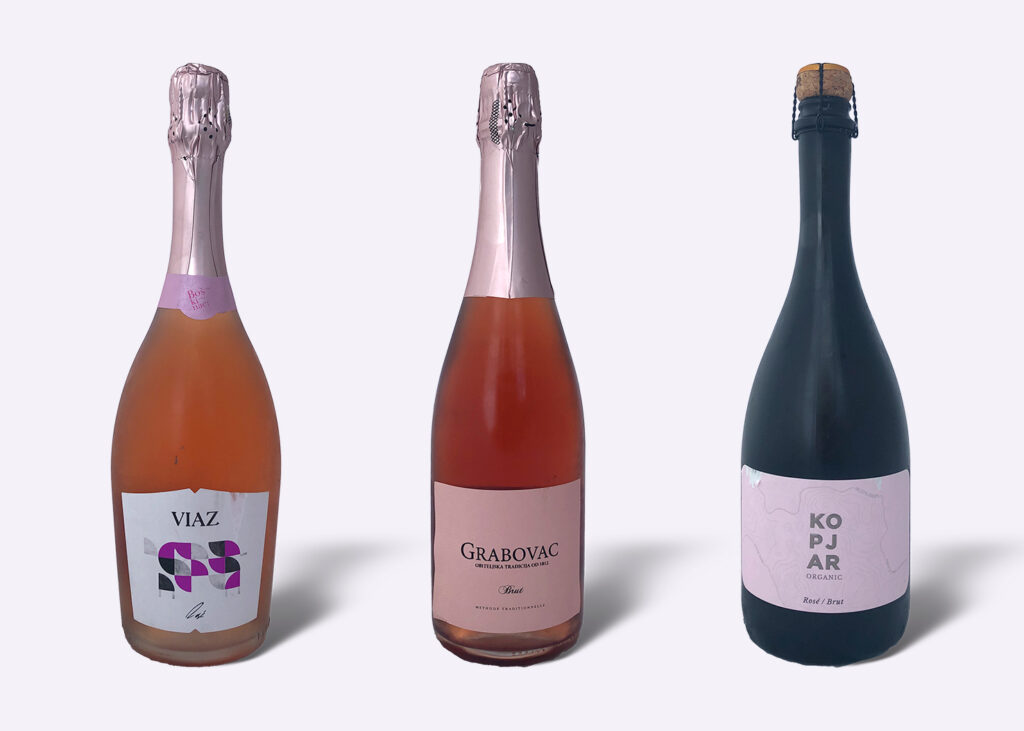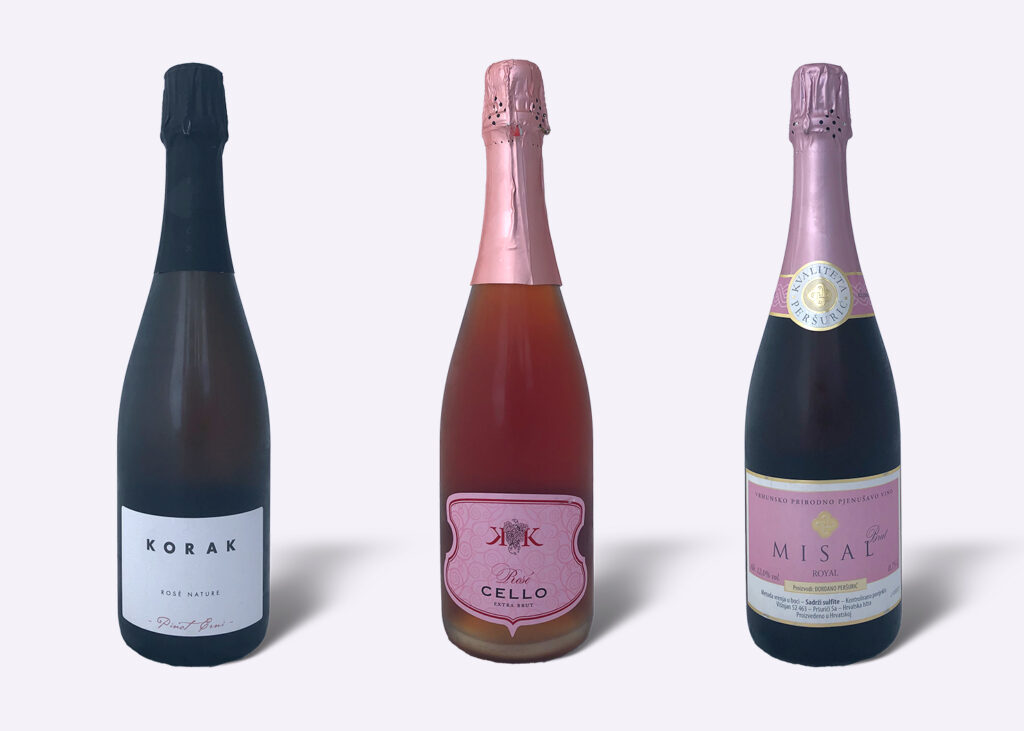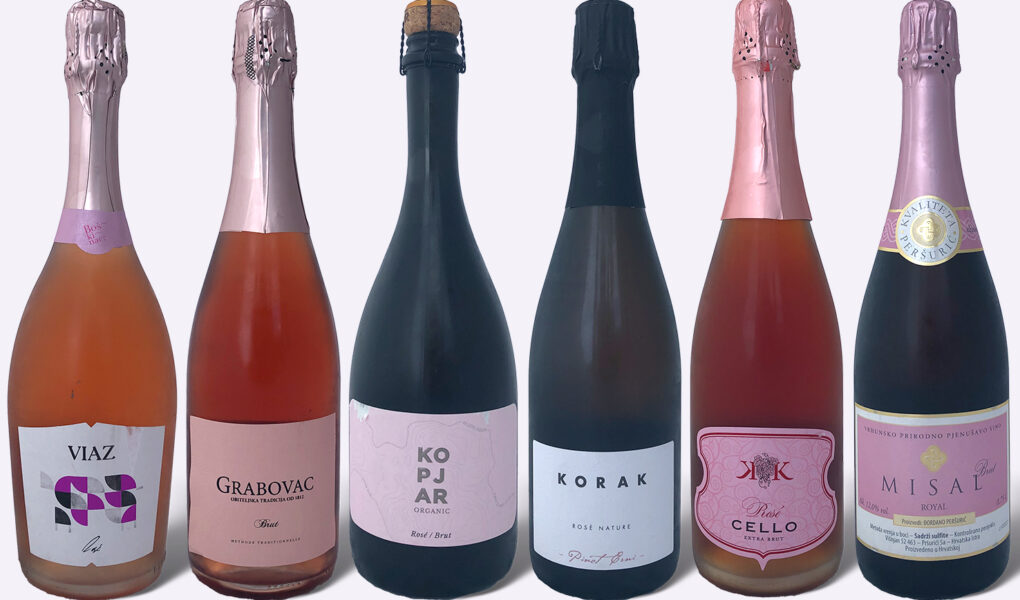Rosé is considered the fun wine of summer, but I have always shown a little more deference to sparkling rosé. I don’t mean pink Prosecco (though it’s yummy) but the kind of sparkling rosé made with the time-consuming Traditional Method used in Champagne. The Traditional Method says “serious wine,” and we sought it out for our tasting of 6 Croatian sparkling rosés.
Traditional Method sparkling rosé is fermented in the same bottle it’s sold in, like Champagne. And it has to age at least 24 months with the yeast lees in the bottle. This means it has more of the rich, toasty flavors of the yeast than sparklers made by simpler methods, like that Prosecco. (For more about the types, read this.)
These wines need not be made with delicate Pinot Noir grapes, as rosés are in Champagne—but I would argue that rosé sparkling wines made with full-bodied, tannic grapes might be missing the point. I’m all for hearty rosés as still wines, but bubbles are by definition light and delicate. You would need a deft hand in the winery to avoid lumbering them with a bulky base wine.
If you’re tasting sparkling rosés in Croatia, expect grapes typical of each region—some heartier and others light. If you love the rich, yeasty flavor of lees, stick with Traditional Method sparkling wines. As in many places outside the Champagne region, these wines are very affordable for the amount of time and effort spent making them.
The Tasting
Note: This tasting is meant to be readable, not comprehensive. We tasted 6 wines, not 60. The wines are listed in alphabetical order by producer. A star (*) indicates wines that stood out for their quality and flavor on the day of the tasting. Prices are those at the winery or winery webshop.

Boškinac Viaz Brut Rosé (Pag) €19
This Merlot-based sparkler charmed us with its bright, pretty aromas of cranberry and red currant. The foamy bubbles were just right, not overwhelming, and the yeasty lees flavors didn’t overpower the fruit but instead added a mild, refreshing bitter note and a hint of salinity. The label design seems to say “basic” rather than “luxury,” but the contents measured up.
Grabovac Brut (Imotski) €22
Guest tasters loved the generous fruit flavors of this dark pink made from regional varieties Trnjak and Vranac as well as Merlot and Cabernet Sauvignon. One commented, “This doesn’t taste like a rosé wine, it’s not delicate,” but tasters went back to it again and again for its strawberry and pink grapefruit flavors with a touch of cinnamon. A robustly satisfying shot of fruit for easy drinking.
Kopjar Brut Rosé 2020 (Zagorje-Međimurje) €18
“I could drink this all day and I wouldn’t get bored with it,” said guest tasters, who liked its “perfumy” and black cherry flavors. It does have an unusual floral note (almost Muscat-like) for a Pinot Noir rosé. Some might find it overly charismatic, but our tasters appreciated its different-ness. The yeasty, yogurty flavors of lees lingered on the finish. A unique sipping wine made from organic grapes.

*Korak Rosé Nature (Plešivica) €26
This pink from Pinot Noir was the most delicate of our lineup, with sophisticated small bubbles and a subtle flavor of lees gently rounding the bright red currant, black cherry and pomegranate fruitiness. “Nature” on the label means this wine was given zero sugar when it was topped up for bottling. In this case, the easygoing acidity and friendly fruit don’t need it. It gets a star for its freshness and elegance, and it pairs beautifully with summer foods.
Korta Katarina Cello Rosé Extra Brut (Pelješac) €26
Of all the rosés we tasted, this one was most like a red—as you might expect from a sparkling wine made from the robust Plavac Mali grape. It had the deepest in color and the most tannin. The flavors nicely balanced a cherry-pomegranate fruitiness with a pronounced yeastiness. But the wine was almost flat and slightly oxidized. A different bottle might be fresher. Tasters found it too big for summery salads, and found themselves thinking of grilled pork instead.
*Misal Royal Brut (Istria) €17
This one everyone agreed on: “one to drink slowly,” “it’s got more to it,” and “a thinking wine” were some of the comments. Its super-richness comes from its heavy lees character—look for brioche rolls, brown butter and yogurty tartness. (Misal is known for keeping wines on the lees longer than required.) But standing right up to the leesy richness is raspberry-pomegranate fruit, a ridge of snappy acidity and just enough tannin to balance the texture. The bubbles are fine and elegant. Made from Pinot Noir.
Cheers Croatia Magazine conducts wine tastings in the semi-blind format. This means that we know what wines we have, but they are placed in numbered bags so we can’t identify them during the tasting. Wines for tastings are purchased, or occasionally donated by the winery. See the magazine’s Affiliations and Gifts Policy for more information.

